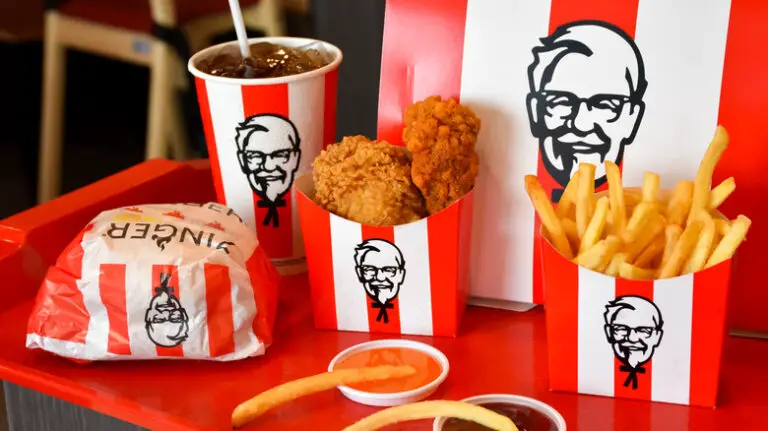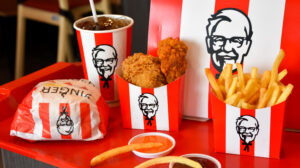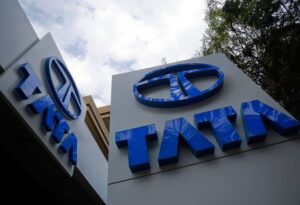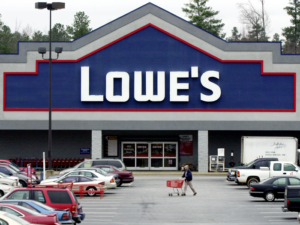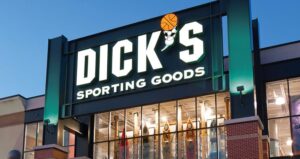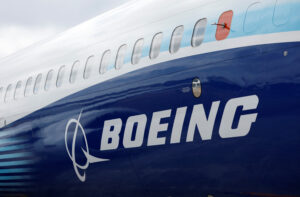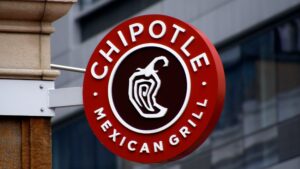KFC, also known as Kentucky Fried Chicken, is a global fast-food chain that specializes in fried chicken. In this SWOT analysis, we will examine its strengths, weaknesses, opportunities, and threats in the fast-food industry.

Jump Ahead To :
Key Takeaways:
- KFC is a global fast-food chain known for its fried chicken.
- SWOT analysis helps evaluate KFC’s internal and external factors.
- KFC’s strengths include its strong brand recognition and wide market presence.
- Weaknesses include a high-calorie menu and limited vegetarian options.
- Opportunities lie in menu innovation and market expansion.
- KFC faces threats from intense competition and supply chain concerns.
- It’s competitors include Popeyes , Jollibee , McDonalds , Burger King , Chick Fil A , Wendys
Strengths of KFC
KFC, also known as Kentucky Fried Chicken, possesses several key strengths that contribute to its competitive advantage in the fast-food industry. These strengths are instrumental in establishing KFC as a global leader in the market.
1. Strong Brand Recognition
KFC boasts a robust and recognized brand that holds immense value in the fast-food sector. With its iconic logo and Colonel Sanders’ image, the brand is instantly identifiable and resonates with customers worldwide. This brand recognition not only drives customer loyalty but also attracts new consumers.
2. Wide Market Presence
KFC’s extensive global footprint sets it apart from its competitors. Operating in over 120 countries with more than 15,000 locations, KFC has established a remarkable market presence. This widespread reach enables the company to cater to diverse consumer preferences and tap into various markets, enhancing its potential for growth and profitability.
3. Financial Stability
KFC’s financial stability is another significant strength. As a subsidiary of Yum! Brands, one of the largest restaurant companies globally, KFC benefits from robust financial resources. This financial stability provides KFC the ability to invest in various initiatives, including marketing campaigns, research and development, and expansion plans, further solidifying its position in the industry.
4. Unique Trade Secret Recipe
An integral part of KFC’s success lies in its unique trade secret recipe, a closely guarded formula known only to a select few individuals. This signature flavor, with its blend of herbs and spices, sets KFC’s fried chicken apart from competitors and keeps customers coming back for more. The recipe’s exclusivity gives KFC an edge in the market, ensuring a distinct and consistent taste that keeps customers loyal.
5. Ownership by Yum! Brands
Being part of the Yum! Brands portfolio provides KFC with significant advantages. Yum! Brands’ portfolio comprises other renowned fast-food chains, such as Taco Bell and Pizza Hut, allowing for cross-promotion and synergies. Additionally, KFC can leverage the resources, expertise, and global network of Yum! Brands to enhance its operations, stay competitive, and adapt to changing consumer demands.
| Strengths of KFC |
|---|
| Strong brand recognition |
| Wide market presence with over 15,000 locations in 120 countries |
| Good financial situation |
| Unique trade secret recipe |
| Ownership by Yum! Brands |
Weaknesses of KFC
KFC, like any other business, faces certain weaknesses and challenges that need to be addressed and overcome in order to maintain its competitive position in the fast-food industry. These weaknesses range from menu-related concerns to issues with its franchise system and limited vegetarian options.
Menu High in Oil and Calories
One of the weaknesses of KFC is that its menu is known for being high in oil and calories. While this has been a part of its brand identity and appeal to many customers, it can be a deterrent for health-conscious individuals who are looking for lighter and healthier options. In an increasingly health-conscious society, KFC may face challenges in attracting and retaining health-conscious consumers.
Franchise System and Inconsistencies
KFC operates under a franchise system, allowing individual franchisees to operate their own KFC restaurants. While this system provides a wide market presence and efficient expansion, it can lead to inconsistencies in product quality, customer service, and overall brand experience. Maintaining consistency across all franchise locations is crucial for KFC’s success and customer loyalty.
Limited Vegetarian Options
Another weakness of KFC is its limited vegetarian options. In a world where dietary preferences and requirements are diverse, offering a variety of vegetarian and vegan options is essential for catering to a wider customer base. Without sufficient vegetarian choices, KFC may miss out on potential customers who follow vegetarian or vegan diets.
Negative Publicity and Criticism
KFC has also faced negative publicity and criticism surrounding its food and supply chain practices. Concerns about the treatment of animals, use of antibiotics, and environmental impact have raised questions about the company’s ethical standards. Addressing these concerns and promoting transparency in its practices can help KFC regain trust and improve its reputation.
“KFC’s weaknesses include a menu high in oil and calories, inconsistencies within its franchise system, limited vegetarian options, and negative publicity surrounding its food and supply chain practices. Overcoming these weaknesses is crucial for KFC to stay competitive in the fast-food industry and appeal to a wider range of customers.”
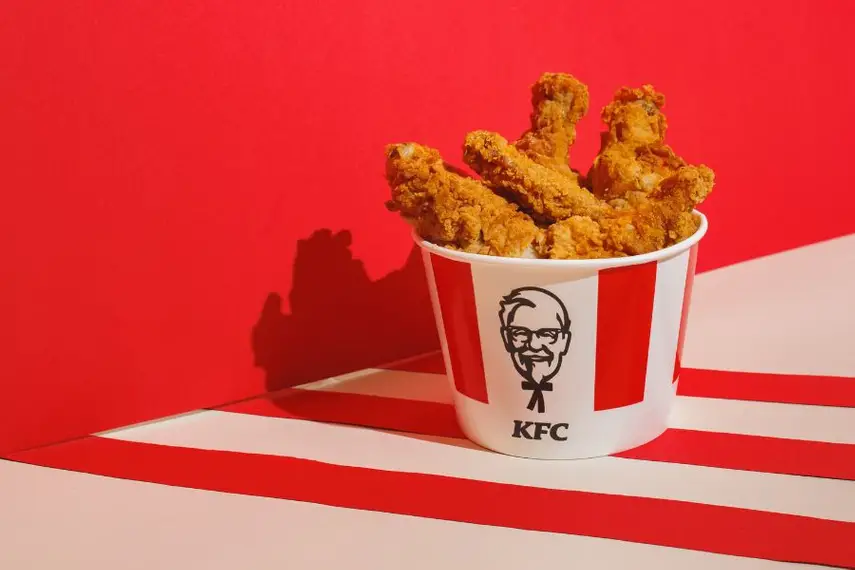
Weaknesses Summary
| Weaknesses | Impact | Potential Solutions |
|---|---|---|
| Menu high in oil and calories | Can deter health-conscious consumers | Introduce healthier menu options without compromising taste |
| Franchise system and inconsistencies | Leads to variations in product quality and customer experience | Implement stricter quality control measures and provide consistent training for franchisees |
| Limited vegetarian options | Misses out on potential customers who follow vegetarian or vegan diets | Expand vegetarian menu offerings and promote them effectively to target audience |
| Negative publicity and criticism | Affects brand reputation and consumer trust | Address concerns, improve supply chain transparency, and communicate ethical practices |
Opportunities for KFC
KFC, as a prominent player in the fast-food industry, has a range of enticing opportunities to explore and capitalize on. By strategically leveraging these opportunities, KFC can further enhance its market presence and customer appeal.
Expanding the Menu for Health-Conscious Consumers
One key opportunity for KFC lies in expanding its menu to cater to the ever-growing demand for healthier dining options. As consumers become increasingly health-conscious, there is a need for KFC to introduce menu items that align with these preferences. By offering alternatives such as grilled chicken, salads, and plant-based protein options, KFC can attract health-conscious individuals who may have previously opted for other dining choices.
Market Penetration in Emerging Regions
Another promising opportunity for KFC is to explore market expansion in emerging regions. As global economies continue to develop, there is an increasing appetite for international fast-food chains. By identifying and strategically entering these new markets, KFC can tap into a vast consumer base, further expanding its global reach and influence.
Capitalizing on the Growing Demand for Food Delivery Services
The rising popularity of food delivery services presents a significant opportunity for KFC. By partnering with popular delivery platforms or establishing its own delivery network, KFC can reach customers who prefer the convenience of ordering food to their doorstep. This strategic move can help KFC differentiate itself from competitors and enhance its accessibility to a wider range of consumers.
Diversifying Offerings to Attract a Broader Audience
With a strong foundation in the fast-food industry, KFC has the advantage of a loyal customer base. However, there is an opportunity for KFC to attract a broader audience by diversifying its offerings. Introducing new items to its chicken line, such as innovative flavors, textures, or spicy variations, can captivate the attention of adventurous eaters. Additionally, KFC can consider expanding its non-chicken options, such as introducing gourmet burgers or vegetarian choices, to cater to different preferences and dietary requirements.
By capitalizing on these opportunities, KFC can reinforce its position as a leading fast-food chain and expand its market share. The next section will address the potential threats that KFC may face, necessitating proactive measures to safeguard its success.
Threats to KFC
KFC, like any other business, faces various threats that can impact its operations and market position. These threats include intense competition from other fast-food chains, the rising trend towards healthy eating, supply chain concerns, potential lawsuits, currency fluctuations, and saturation in developed fast food markets.
Intense Competition from Other Fast-Food Chains
One of the major threats to KFC is the intense competition it faces from other fast-food chains. Competitors such as McDonald’s, Burger King, and Subway have a significant presence globally, and they constantly strive to attract customers by offering similar products and promotions. KFC must continuously innovate and differentiate itself to stay ahead in this highly competitive landscape.
The Trend Towards Healthy Eating
Another threat that KFC encounters is the increasing trend towards healthy eating. With more people becoming health-conscious, there is a growing demand for healthier food options. This poses a challenge for KFC, as its core product is fried chicken, which may not align with consumers’ health preferences. To address this threat, KFC can explore menu diversification by introducing healthier alternatives and promoting them to target health-conscious customers.
“The rising trend towards healthy eating poses a challenge for KFC, but it can be addressed by introducing healthier alternatives and promoting them to health-conscious customers.”
Supply Chain Concerns
KFC faces supply chain concerns that can have a significant impact on its operations and reputation. Criticism regarding animal welfare and the use of antibiotics in poultry sourcing has raised concerns among consumers. To mitigate these threats, KFC should prioritize transparency and sustainability in its supply chain practices, ensuring ethical sourcing and addressing any issues promptly.
Potential Impact of Lawsuits
Like any large corporation, KFC is also vulnerable to potential lawsuits that may arise from various factors, such as food safety issues or employment-related matters. These lawsuits can have a negative impact on the brand reputation and financial stability of the company. KFC needs to maintain strict quality control standards and adhere to labor laws to minimize the risk of lawsuits and protect its business interests.
Currency Fluctuations and Saturated Fast Food Markets
KFC’s global operations make it susceptible to currency fluctuations, which can affect its financial performance in different markets. Additionally, developed economies, especially in North America and parts of Europe, have saturated fast food markets, making it challenging for KFC to expand and gain market share. To mitigate these threats, KFC can focus on expanding its presence in emerging markets where there is still potential for growth.
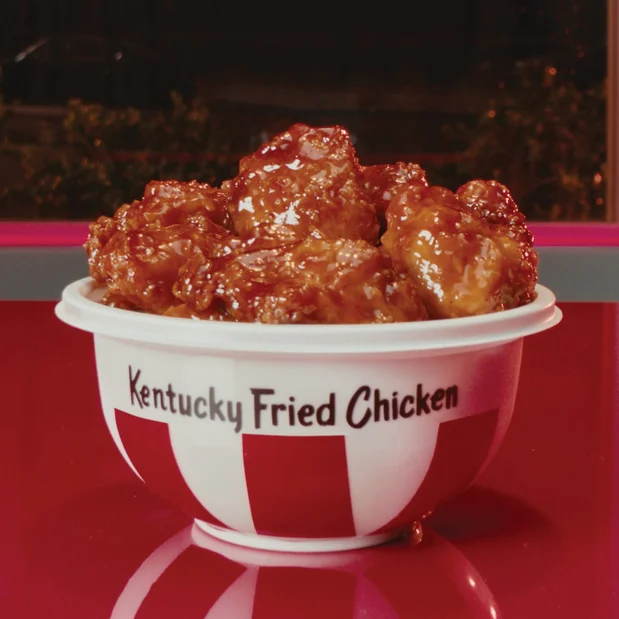
Despite these threats, KFC has proven resilience and adaptability as a brand. By closely monitoring market trends, staying ahead of the competition, addressing supply chain concerns, and implementing effective risk management strategies, KFC can navigate these challenges and continue to be a prominent player in the fast-food industry.
Brand Recognition as a Strength
KFC’s strong brand recognition is a key strength due to its global presence and household name status. With a presence in over 120 countries, KFC has established itself as a leader in the fast-food industry. Its distinctive logo and Colonel Sanders’ image contribute to its brand recognition.
Not only is KFC widely recognized, but it also holds a significant place in the hearts and minds of consumers around the world. The iconic red and white logo, featuring Colonel Sanders, is instantly recognizable, evoking a sense of familiarity and trust. This brand recognition has been built over years of consistent marketing efforts, quality products, and memorable advertising campaigns.
One of the primary advantages of strong brand recognition is the ability to attract and retain customers. When consumers are familiar with a brand, they are more likely to choose it over competitors. KFC’s global presence further reinforces its brand recognition, as it can be found in multiple countries, making it accessible to a diverse customer base.
“KFC’s brand recognition sets it apart from the competition, giving it a unique position in the fast-food industry. Its global presence and iconic logo make it instantly identifiable and appealing to consumers worldwide.”
Furthermore, brand recognition also plays a crucial role in brand loyalty. Customers who have positive experiences with KFC are more likely to become repeat customers and advocate for the brand. This word-of-mouth marketing, fueled by brand recognition, helps generate positive buzz and attract new customers.
About 80% of KFC’s locations are operated by franchisees, who benefit from the brand recognition and the marketing efforts of the global brand. This cooperation between KFC and its franchise partners strengthens the company’s market presence and reinforces its brand recognition.
Brand Recognition Case Study: KFC’s “Finger Lickin’ Good” Slogan
An excellent example of KFC’s brand recognition is its famous slogan, “Finger Lickin’ Good.” This catchphrase has become synonymous with the brand, reflecting the taste and quality of KFC’s fried chicken. It has been used in various marketing campaigns and has become deeply ingrained in the minds of consumers as a representation of KFC’s delicious offerings. It’s a testament to the power of brand recognition in establishing a strong connection with consumers.
Overall, KFC’s brand recognition, supported by its global presence and iconic logo, is a significant strength in the fast-food industry. It sets KFC apart from competitors, attracts customers, fosters brand loyalty, and contributes to the company’s continued success.
Market Expansion as an Opportunity
Market expansion presents a significant opportunity for KFC to continue its growth trajectory and strengthen its position in the fast-food industry. By strategically entering new markets and tapping into untapped potential, KFC can reach a wider customer base and capitalize on emerging consumer trends.
With its strong brand recognition and global reach, KFC has a solid foundation for market expansion. The well-known logo and iconic image of Colonel Sanders have become synonymous with delicious fried chicken, making KFC a familiar and trusted name worldwide.
One of the key advantages of market expansion is the ability to adapt to local preferences. KFC can tailor its menu offerings to cater to the specific tastes and preferences of each market, ensuring a customized experience for customers. By offering a mix of globally popular items and localized dishes, KFC can attract a diverse range of consumers and establish a strong presence in new territories.
Key Benefits of Market Expansion for KFC:
- Increased market share: By expanding into new markets, KFC can capture additional market share and solidify its position as a global leader in the fast-food industry. This expansion allows the brand to tap into new customer segments and diversify its revenue streams.
- Diversification of risks: Operating in multiple markets helps KFC mitigate risks associated with economic fluctuations in specific regions. By spreading its presence across various countries, KFC can minimize the impact of localized challenges and ensure a more stable business performance overall.
- Access to new consumer segments: Market expansion allows KFC to tap into new consumer segments, expanding beyond its traditional customer base. With each new market, the brand can attract a fresh set of customers who may have different preferences and purchasing behaviors.
“Market expansion offers KFC the opportunity to extend its global reach and establish itself as a dominant player in new markets. By leveraging its existing strengths and adapting to local demands, KFC can expand its customer base and gain a competitive edge in the fast-food industry.” – Industry Analyst
In summary, market expansion is a crucial opportunity for KFC to further grow its brand and solidify its position as a global leader in the fast-food industry. By leveraging its brand recognition, adapting to local preferences, and diversifying its customer base, KFC can realize the full potential of new markets and enhance its overall market presence.
| Benefits of Market Expansion | Description |
|---|---|
| Increased market share | Expanding into new markets allows KFC to capture additional market share and diversify its revenue streams. |
| Diversification of risks | Operating in multiple markets helps KFC mitigate risks associated with economic fluctuations in specific regions. |
| Access to new consumer segments | Market expansion enables KFC to tap into new customer segments and attract a diverse range of consumers. |

Menu Innovation as an Opportunity
Menu innovation is a vital aspect of staying relevant in the fast-food industry. For KFC, it presents an exciting opportunity to meet the changing demands and preferences of consumers, particularly when it comes to healthier food choices.
With a growing awareness of the importance of balanced nutrition, more and more people are seeking out options that align with their health goals. By introducing a range of reduced-fat, low-calorie, and other healthier menu items, KFC can successfully tap into this market and attract a broader customer base.
One approach to menu innovation could be the introduction of grilled chicken options. Grilled chicken is a healthier alternative to fried chicken, and by including it alongside their signature fried chicken, KFC can cater to a wider range of dietary preferences. These options could include grilled chicken wraps, salads, or even grilled chicken sandwiches.
Additionally, KFC could explore the use of alternative ingredients and cooking methods that reduce oil and calorie content without compromising taste. This could involve experimenting with air frying, baking, or using healthier oils in the preparation of their popular items.
It is essential for KFC to strike a balance between maintaining their core menu offerings while incorporating healthier alternatives. By doing so, they can transition towards a more inclusive brand that caters to both traditional fans and health-conscious consumers.
Menu innovation also presents an opportunity for KFC to showcase their commitment to continuous improvement and adapting to evolving consumer needs. This can enhance their brand reputation and establish them as a forward-thinking player in the competitive fast-food industry.
Quotes:
“By introducing reduced-fat, low-calorie, and other healthier options, KFC can attract a broader customer base and stay relevant in the competitive fast-food industry.”
“One approach to menu innovation could be the introduction of grilled chicken options […] KFC can cater to a wider range of dietary preferences.”
“Menu innovation also presents an opportunity for KFC to showcase their commitment to continuous improvement and adapting to evolving consumer needs.”
By embracing menu innovation and offering healthier options, KFC can position itself as a brand that cares about its customers’ well-being. This proactive approach not only attracts health-conscious consumers but also strengthens customer loyalty and contributes to long-term success.
Intense Competition as a Threat
KFC operates in a highly competitive fast food industry, facing fierce competition from major chains like McDonald’s and Burger King. This intense competition poses a threat to KFC’s market share and profitability. To stay ahead in this cutthroat industry, KFC must adopt strategies that differentiate itself from its rivals, attract customers, and maintain a competitive edge.
One way KFC can tackle intense competition is by offering unique menu options that set it apart from its competitors. By continually innovating and introducing new and exciting dishes, KFC can attract customers looking for something different. From limited-time promotions to exclusive menu items, KFC can leverage its culinary expertise to capture the attention and taste buds of fast food enthusiasts.
Moreover, effective marketing strategies play a crucial role in combating competition. KFC can invest in targeted advertising campaigns that highlight its brand’s strengths, such as its world-famous fried chicken and finger-lickin’ good flavors. Engaging with customers through social media platforms and personalized marketing initiatives can also help build brand loyalty and create a unique customer experience.
KFC’s signature fried chicken recipe and brand heritage are powerful assets that can aid in maintaining a competitive edge. By staying true to its roots and consistently delivering the quality that customers expect from KFC, the brand can retain its loyal fan base while attracting new customers.
In summary, KFC must navigate the challenges posed by intense competition in the fast food industry. By offering innovative menu options, implementing effective marketing strategies, and leveraging its signature fried chicken recipe and brand heritage, KFC can stay ahead of the competition and continue to thrive in the ever-evolving fast food landscape.
Supply Chain Concerns as a Threat
KFC has faced criticism and negative publicity regarding its supply chain practices, including issues related to animal welfare and antibiotics. These concerns have raised questions about the ethical sourcing of KFC’s ingredients and the overall sustainability of its supply chain. To address these concerns and protect its brand reputation, KFC must prioritize transparency and sustainability in its sourcing practices.
One of the key areas of concern is animal welfare. KFC’s supply chain has been under scrutiny for its treatment of chickens, including issues such as overcrowding, unnatural living conditions, and the use of antibiotics. This not only raises ethical concerns but also poses health risks due to the potential development of antibiotic-resistant bacteria.
To mitigate these risks, KFC should implement stricter guidelines for animal welfare throughout its supply chain. This includes ensuring that chickens are raised in humane conditions, with sufficient space and access to natural behaviors. KFC should also consider supporting and promoting the use of alternative farming practices, such as organic and free-range methods, to reduce the reliance on antibiotics and improve the overall welfare of the animals.
Additionally, maintaining strong relationships with suppliers is crucial for KFC to ensure ethical sourcing practices. By working closely with suppliers and conducting regular audits, KFC can monitor and enforce compliance with its ethical standards. This includes verifying that suppliers adhere to responsible agricultural practices, follow fair labor practices, and prioritize sustainable sourcing of ingredients.
Implementing stricter guidelines for animal welfare and maintaining supplier relationships can help mitigate risks and protect KFC’s brand reputation.
Furthermore, KFC should prioritize transparency in its supply chain. This includes providing clear and detailed information about the sourcing and origin of its ingredients. By adopting technologies such as blockchain, KFC can enhance traceability and accountability throughout its supply chain. This not only reassures consumers about the ethical sourcing of KFC’s products but also allows for prompt identification and resolution of any potential issues or risks.
By addressing supply chain concerns and actively working towards ethical sourcing practices, KFC can demonstrate its commitment to responsible business operations and sustainability. This not only aligns with evolving consumer expectations but also helps to mitigate risks and maintain a positive brand image in an increasingly conscious and competitive market.
Conclusion
In conclusion, this SWOT analysis of KFC provides valuable business insights into the fast-food industry. It highlights KFC’s strengths, weaknesses, opportunities, and threats, allowing the company to make informed strategic decisions. By leveraging its strengths, such as strong brand recognition and a wide market presence, KFC can maintain its position as a global leader in the fast-food sector.
Addressing weaknesses, such as the menu high in oil and limited vegetarian options, is crucial for KFC to cater to evolving consumer preferences and enhance its competitiveness. Furthermore, by capitalizing on opportunities like market expansion and menu innovation, KFC can tap into new customer segments and stay relevant in the highly competitive industry.
Understanding the competitive landscape and consumer preferences is vital for KFC’s success. By continuously analyzing the industry trends and adapting its strategies accordingly, KFC can navigate the challenges and seize growth opportunities. With a thorough understanding of its SWOT analysis, KFC is well-positioned to make strategic business decisions that drive future success.
